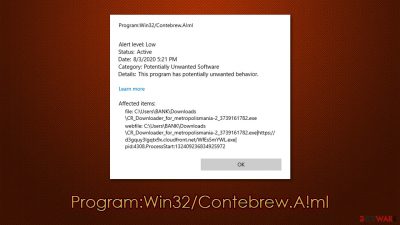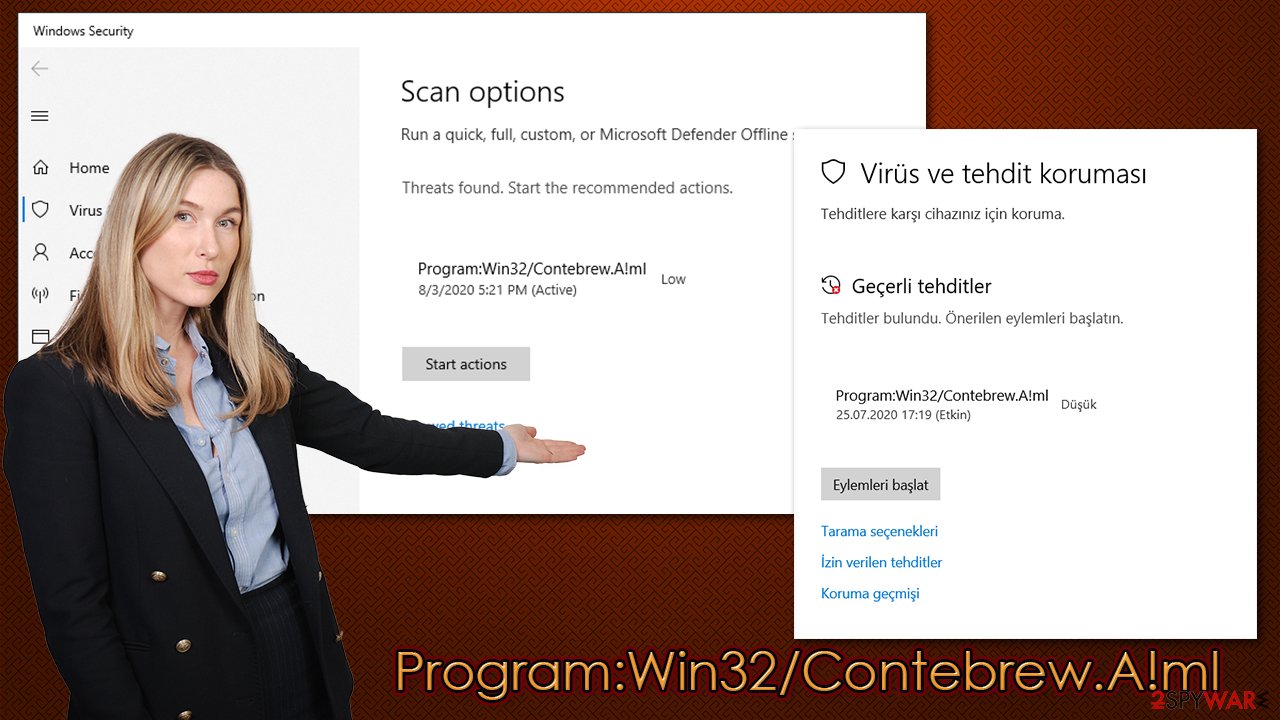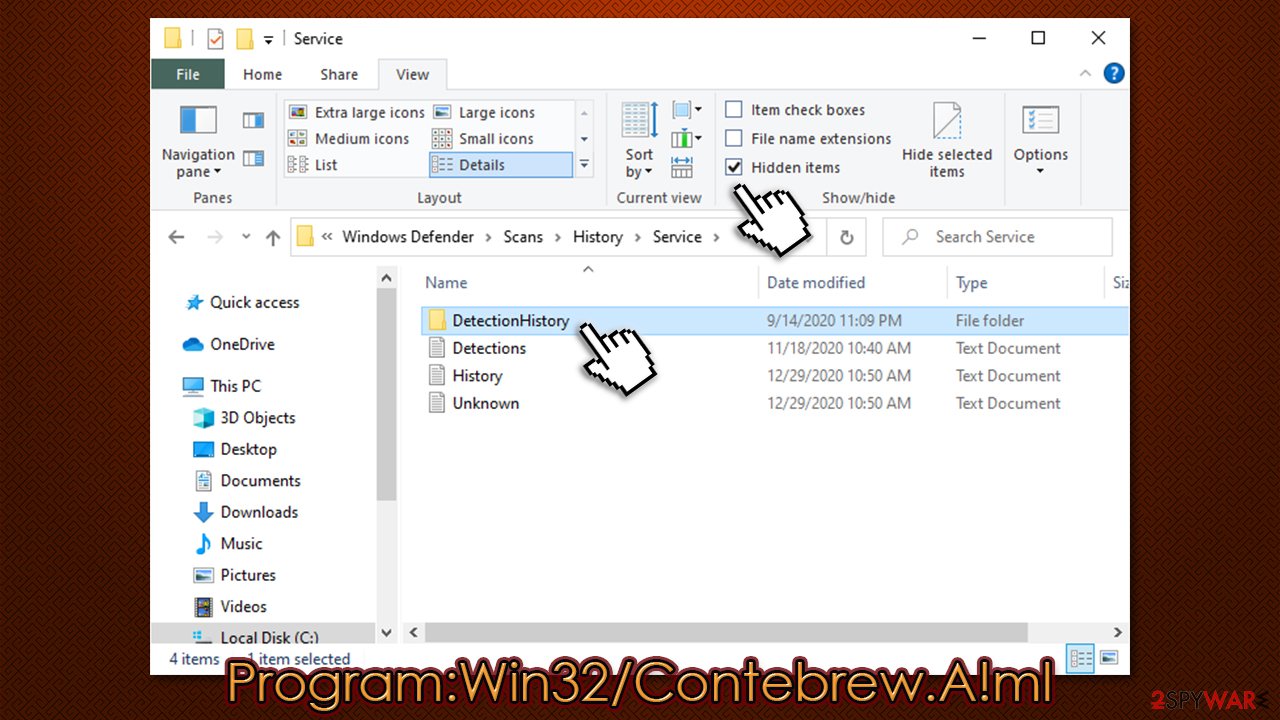Program:Win32/Contebrew.A!ml (Removal Instructions) - Free Guide
Program:Win32/Contebrew.A!ml Removal Guide
What is Program:Win32/Contebrew.A!ml?
Program:Win32/Contebrew.A!ml is a detection name for a potentially unwanted program that is trying to break into your device

Program:Win32/Contebrew.A!ml is an adware application that you could have downloaded in a bundle from a suspicious website, or you were tricked into believing that it is useful in the first place. The threat is typically identified by Windows Defender, although other security apps can use the same name. It belongs to a potentially unwanted program category, which typically represents changes made to Google Chrome, Mozilla Firefox, MS Edge, Safari, or another web browser.
Thus, if the PUP manages to break in, you might see the homepage and new tab address changes, redirects to suspicious websites, and ads showing up during your web browsing sessions, namely popups, banners, deals, coupons, offers, and other intrusive content.
The problem with this potentially unwanted program is that the threat is persistent, and users said they struggled with Program:Win32/Contebrew.A!ml removal. This typically occurs due to a Windows cache bug that can be cleared and the repeated detection terminated for good – check below how.
| Name | Program:Win32/Contebrew.A!ml |
|---|---|
| Type | Adware, potentially unwanted program |
| Distribution | Software bundles, deceptive ads, fake Flash Player updates, third-party websites |
| Symptoms | Inability to eliminate the potentially unwanted program; unknown browser extension or application installed; intrusive deals, coupons, discounts, offers, and other advertisements; redirects to ad-filled, scam, phishing, and other dangerous websites |
| Dangers | Redirects to malicious websites can result in unwanted site notifications, personal information disclosure to unknown parties, financial losses, installation of other potentially unwanted software or malware |
| Similar | Win32/Bundpil, PUA:Win32/Puwaders.B!ml, VirTool:Win32/DefenderTamperingRestore |
| Elimination | While it is usually easy to uninstall potentially unwanted applications, some threats just don't want to go away – and this is precisely the case. In order to get your security software to stop repeatedly detecting this threat, you need to clear the detection history within Windows Defender folder |
| Further steps | Malware or adware infections can diminish the performance of your computer or cause serious stability issues. Use FortectIntego to remediate your device and ensure that the virus damage is fixed |
Adware programs are generally not considered malicious, although some security advocates and researchers claim that some adware might compromise user security and open the system to additional infections. Thus, there is a great need to prevent infiltration of such programs, as they also rarely provide any useful functionality to users in the first place.
Once installed, Program:Win32/Contebrew.A!ml virus focus shifts to delivering intrusive ad campaigns, meaning that those infected would see various ads while browsing the web. Homepage, search provider, and other browser changes can also accompany the unwanted behavior.
Redirects might also occur, landing users on websites that advertise useless software, attempt to extort money with phishing techniques, or include malicious JavaScript[1] that would download and install malware automatically under certain circumstances.
It is also important to note that most potentially unwanted programs such as adware collect a variety of information about users' online activities. With the help of cookies, web beacons, and other tracking technologies, the following data is automatically harvested and later used for marketing purposes:
- IP address
- Internet Service Provider
- Approximate location
- Timestamps
- Links clicked and sites visited
- Search queries
- Technical device data
- Installed apps and extensions, etc.
However, if you have your computer equipped with security software such as Windows Defender, it would flag the intrusion as soon as Program:Win32/Contebrew.A!ml would attempt to break in. Unfortunately, users said that the main problem with this detection is that it would not go away and show up regularly, up to a few times a day. They also claimed that they quarantined the threat once it showed up.

There could be a few reasons why this is happening: either there is additional malware installed on the system, Windows Defender can't fully eliminate the PUP or a bug within the Detection history folder. Thus, you should employ different security software, such as SpyHunter 5Combo Cleaner or Malwarebytes, and perform a full system scan to remove Program:Win32/Contebrew.A!ml. To ensure that the machine is running well, we also recommend trying the FortectIntego repair tool. You could again try to delete the detection history for Windows Defender – you can find more details below.
Beware of malicious sites when downloading new software
Many people like to download new software – and it's best when it's free. Unfortunately, third-party software sites serve as a perfect ground for distributing adware and similar unwanted programs, researchers warn.[2] Hence, users who carelessly download apps end up also installing additional components due to a lack of attentiveness. Of course, the distributors of PUPs are also at fault, as they are actively trying to hide promotional offers within the standalone installer.
Thus, you should always be aware that installers could and most commonly do include additional apps within them. You should always pick Advanced/Custom settings instead of recommended ones when prompted and remove all the ticks next to browser extensions, system optimizers, video players, and similar apps. You should also watch out for fine print text, misleading offers, misplaced buttons, and similar tricks used to mislead users into installing adware or other unwanted software on their machines.
There have been sightings of browser-hijacking and adware apps that come as add-ons for video games. For example, one user claimed that they were struck with an anti-virus popup when they tried downloading a mod (mods are small files that can make significant changes within a game environment) for Minecraft.[3] While such files are liked by the community, it is crucial to ensure that no unknown websites are used for such a purpose.
Program:Win32/Contebrew.A!ml removal details
If you are using Windows Defender as your main anti-malware tool, all you have to do is quarantine and remove Program:Win32/Contebrew.A!ml from your system for good. However, as already mentioned, many users claimed that they could not get rid of the continuous popups despite performing the regular actions that should contain the infection. If that has happened to you, you could check the list of the installed programs on your system, clear your browsers and uninstall unwanted extensions as explained below.
In most cases, a full Program:Win32/Contebrew.A!ml removal can not be achieved due to a bug within the Windows Defender engine. It sometimes detects the same threat repeatedly, even though it claims it has been eliminated for good. In order to bypass this, you should do the following:
- Open File Explorer by pressing Win + E
- Go to View tab at the top and tick the Hidden items option
- Now navigate to C:\ProgramData\Microsoft\Windows Defender\Scans\History\Service folder
- In here, delete the DetectionHistory folder by pressing Shift + Del on your keyboard.

You may remove virus damage with a help of FortectIntego. SpyHunter 5Combo Cleaner and Malwarebytes are recommended to detect potentially unwanted programs and viruses with all their files and registry entries that are related to them.
Getting rid of Program:Win32/Contebrew.A!ml. Follow these steps
Uninstall from Windows
You can uninstall programs from Windows systems by following this guide:
Instructions for Windows 10/8 machines:
- Enter Control Panel into Windows search box and hit Enter or click on the search result.
- Under Programs, select Uninstall a program.

- From the list, find the entry of the suspicious program.
- Right-click on the application and select Uninstall.
- If User Account Control shows up, click Yes.
- Wait till uninstallation process is complete and click OK.

If you are Windows 7/XP user, proceed with the following instructions:
- Click on Windows Start > Control Panel located on the right pane (if you are Windows XP user, click on Add/Remove Programs).
- In Control Panel, select Programs > Uninstall a program.

- Pick the unwanted application by clicking on it once.
- At the top, click Uninstall/Change.
- In the confirmation prompt, pick Yes.
- Click OK once the removal process is finished.
Delete from macOS
macOS users can suffer from the adware as well – here's how to get rid of it:
Remove items from Applications folder:
- From the menu bar, select Go > Applications.
- In the Applications folder, look for all related entries.
- Click on the app and drag it to Trash (or right-click and pick Move to Trash)

To fully remove an unwanted app, you need to access Application Support, LaunchAgents, and LaunchDaemons folders and delete relevant files:
- Select Go > Go to Folder.
- Enter /Library/Application Support and click Go or press Enter.
- In the Application Support folder, look for any dubious entries and then delete them.
- Now enter /Library/LaunchAgents and /Library/LaunchDaemons folders the same way and terminate all the related .plist files.

Remove from Microsoft Edge
Delete unwanted extensions from MS Edge:
- Select Menu (three horizontal dots at the top-right of the browser window) and pick Extensions.
- From the list, pick the extension and click on the Gear icon.
- Click on Uninstall at the bottom.

Clear cookies and other browser data:
- Click on the Menu (three horizontal dots at the top-right of the browser window) and select Privacy & security.
- Under Clear browsing data, pick Choose what to clear.
- Select everything (apart from passwords, although you might want to include Media licenses as well, if applicable) and click on Clear.

Restore new tab and homepage settings:
- Click the menu icon and choose Settings.
- Then find On startup section.
- Click Disable if you found any suspicious domain.
Reset MS Edge if the above steps did not work:
- Press on Ctrl + Shift + Esc to open Task Manager.
- Click on More details arrow at the bottom of the window.
- Select Details tab.
- Now scroll down and locate every entry with Microsoft Edge name in it. Right-click on each of them and select End Task to stop MS Edge from running.

If this solution failed to help you, you need to use an advanced Edge reset method. Note that you need to backup your data before proceeding.
- Find the following folder on your computer: C:\\Users\\%username%\\AppData\\Local\\Packages\\Microsoft.MicrosoftEdge_8wekyb3d8bbwe.
- Press Ctrl + A on your keyboard to select all folders.
- Right-click on them and pick Delete

- Now right-click on the Start button and pick Windows PowerShell (Admin).
- When the new window opens, copy and paste the following command, and then press Enter:
Get-AppXPackage -AllUsers -Name Microsoft.MicrosoftEdge | Foreach {Add-AppxPackage -DisableDevelopmentMode -Register “$($_.InstallLocation)\\AppXManifest.xml” -Verbose

Instructions for Chromium-based Edge
Delete extensions from MS Edge (Chromium):
- Open Edge and click select Settings > Extensions.
- Delete unwanted extensions by clicking Remove.

Clear cache and site data:
- Click on Menu and go to Settings.
- Select Privacy, search and services.
- Under Clear browsing data, pick Choose what to clear.
- Under Time range, pick All time.
- Select Clear now.

Reset Chromium-based MS Edge:
- Click on Menu and select Settings.
- On the left side, pick Reset settings.
- Select Restore settings to their default values.
- Confirm with Reset.

Remove from Mozilla Firefox (FF)
Look for unwanted browser extensions within Mozilla Firefox browser:
Remove dangerous extensions:
- Open Mozilla Firefox browser and click on the Menu (three horizontal lines at the top-right of the window).
- Select Add-ons.
- In here, select unwanted plugin and click Remove.

Reset the homepage:
- Click three horizontal lines at the top right corner to open the menu.
- Choose Options.
- Under Home options, enter your preferred site that will open every time you newly open the Mozilla Firefox.
Clear cookies and site data:
- Click Menu and pick Settings.
- Go to Privacy & Security section.
- Scroll down to locate Cookies and Site Data.
- Click on Clear Data…
- Select Cookies and Site Data, as well as Cached Web Content and press Clear.

Reset Mozilla Firefox
If clearing the browser as explained above did not help, reset Mozilla Firefox:
- Open Mozilla Firefox browser and click the Menu.
- Go to Help and then choose Troubleshooting Information.

- Under Give Firefox a tune up section, click on Refresh Firefox…
- Once the pop-up shows up, confirm the action by pressing on Refresh Firefox.

Remove from Google Chrome
To clean Google Chrome, you should access the settings section of the web browser:
Delete malicious extensions from Google Chrome:
- Open Google Chrome, click on the Menu (three vertical dots at the top-right corner) and select More tools > Extensions.
- In the newly opened window, you will see all the installed extensions. Uninstall all the suspicious plugins that might be related to the unwanted program by clicking Remove.

Clear cache and web data from Chrome:
- Click on Menu and pick Settings.
- Under Privacy and security, select Clear browsing data.
- Select Browsing history, Cookies and other site data, as well as Cached images and files.
- Click Clear data.

Change your homepage:
- Click menu and choose Settings.
- Look for a suspicious site in the On startup section.
- Click on Open a specific or set of pages and click on three dots to find the Remove option.
Reset Google Chrome:
If the previous methods did not help you, reset Google Chrome to eliminate all the unwanted components:
- Click on Menu and select Settings.
- In the Settings, scroll down and click Advanced.
- Scroll down and locate Reset and clean up section.
- Now click Restore settings to their original defaults.
- Confirm with Reset settings.

Delete from Safari
Remove unwanted extensions from Safari:
- Click Safari > Preferences…
- In the new window, pick Extensions.
- Select the unwanted extension and select Uninstall.

Clear cookies and other website data from Safari:
- Click Safari > Clear History…
- From the drop-down menu under Clear, pick all history.
- Confirm with Clear History.

Reset Safari if the above-mentioned steps did not help you:
- Click Safari > Preferences…
- Go to Advanced tab.
- Tick the Show Develop menu in menu bar.
- From the menu bar, click Develop, and then select Empty Caches.

After uninstalling this potentially unwanted program (PUP) and fixing each of your web browsers, we recommend you to scan your PC system with a reputable anti-spyware. This will help you to get rid of Program:Win32/Contebrew.A!ml registry traces and will also identify related parasites or possible malware infections on your computer. For that you can use our top-rated malware remover: FortectIntego, SpyHunter 5Combo Cleaner or Malwarebytes.
How to prevent from getting adware
Choose a proper web browser and improve your safety with a VPN tool
Online spying has got momentum in recent years and people are getting more and more interested in how to protect their privacy online. One of the basic means to add a layer of security – choose the most private and secure web browser. Although web browsers can't grant full privacy protection and security, some of them are much better at sandboxing, HTTPS upgrading, active content blocking, tracking blocking, phishing protection, and similar privacy-oriented features. However, if you want true anonymity, we suggest you employ a powerful Private Internet Access VPN – it can encrypt all the traffic that comes and goes out of your computer, preventing tracking completely.
Lost your files? Use data recovery software
While some files located on any computer are replaceable or useless, others can be extremely valuable. Family photos, work documents, school projects – these are types of files that we don't want to lose. Unfortunately, there are many ways how unexpected data loss can occur: power cuts, Blue Screen of Death errors, hardware failures, crypto-malware attack, or even accidental deletion.
To ensure that all the files remain intact, you should prepare regular data backups. You can choose cloud-based or physical copies you could restore from later in case of a disaster. If your backups were lost as well or you never bothered to prepare any, Data Recovery Pro can be your only hope to retrieve your invaluable files.
- ^ Andra Zaharia. (UPDATED 2020) JavaScript Malware – a Growing Trend Explained for Everyday Users. Heimdal Security. Research blog.
- ^ Usunwirusa. Usunwirusa. Cybersecurity news and malware insights.
- ^ What is Win32/Contebrew.A!ml?. Reddit. Social network.























